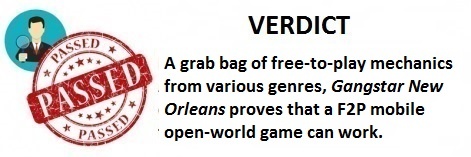Welcome back to the In-App Purchase Inspector - our regular look at free-to-play games from the consumer's perspective.
In each instalment, we consider the incentives or pressure applied to make in-app purchases, their perceived value, the expansion offered by IAPs and the overall value of the experience.
The end goal is to see whether the game makes a good enough case for us to part with our cash, or whether players are content - or engaged enough - to 'freeload'.
This time, we're taking a look at Gangstar New Orleans, the first entry in Gameloft's Grand Theft Auto-inspired open-world series to be designed for free-to-play.
Small screen, big world
With a freely explorable world that's more than nine times the size of any previous series entry, Gangstar New Orleans took Gameloft over two years to develop.
It's a massive statement from the studio, and a gamble on what is, in the mobile free-to-play space at least, an untested genre.
Gameplay-wise, Gangstar New Orleans works to a formula we're all very much familiar with.
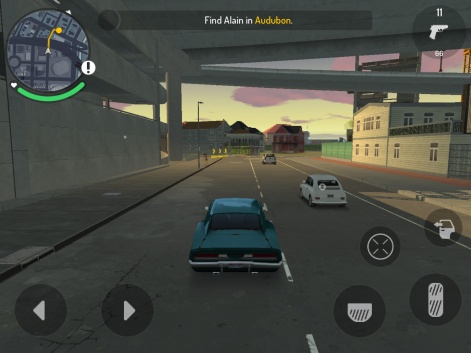
You steal a car, drive to a waypoint on a bustling city map - attacking some civilians along the way, if you so desire - accept a mission, and then either drive or shoot your way to completing its objectives.
Gameloft has been forced to establish its own formula for open-world monetisation.
But when it comes to monetisation, Gameloft has been forced to establish the formula itself.
Does crime pay?
In an interview with PocketGamer.biz before the game launched, the Gangstar team at Gameloft Montreal were at great pains to explain that it didn't want to “force players out” with its monetisation.
And to a point, this is true. You can roam the streets of New Orleans for as long as you like, with no restriction. There is, however, an energy system that prevents the player from ploughing through missions too quickly.
Your maximum energy can be increased along the way thanks to daily quest rewards, but if you run dry it will cost you 30 Diamonds to refill.
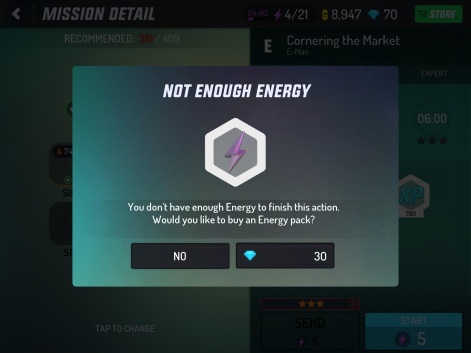
Diamonds are the game's hard currency, available in bundles ranging from 135 for $4.99 to 3,100 for $99.99.
At this pricing, that works out at around $1.10 to refill your energy - although saving up Diamonds by completing quests, while a lengthy process, is also possible.
It works out at around $1.10 to refill your energy.
Another resource Diamonds can be used to buy is Cash, the game's soft currency, which can be bought in bundles ranging from 2,000 for 20 Diamonds to 200,000 for 2,000 Diamonds.
Surprise yourself
Interestingly, however, the thrust of Gangstar New Orleans' monetisation is based around systems akin to the gacha-collection-fusion of team-based RPGs.
Here, the focus is on weapons, vehicles and thugs. The first two are your tools with which to complete missions, meaning their quality has a significant bearing on your chances of success.
Thugs, meanwhile, can be assigned to protect territory against other players in the ongoing tussle for control that is the PvP Turf Wars element.
All three are summoned through Spirit Jars. These can be bought for 100 Diamonds apiece (approximately $3.70), summoning a weapon, vehicle or thug ranked two stars or higher.
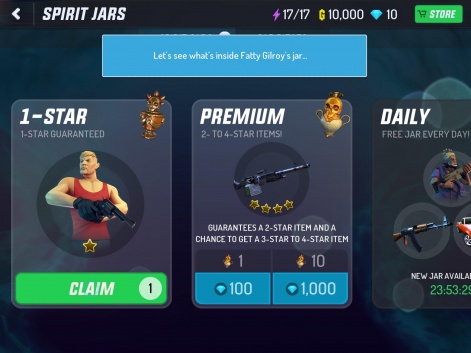
A free daily jar also offers a one-star reward every 24 hours, while another free jar containing smaller prizes like Cash and Fusion Boosters is unlocked every four hours.
Further to this, there are also Spirit Jar pieces dotted around the world to collect.
There's a difficulty curve that always threatens to make your existing gear obsolete.
Pick up enough, and you can construct a full Spirit Jar - more common pieces building towards regular rewards, while completing rarer jars can get you three and four-star rewards.
Power up
Like with a number of mobile shooters, and indeed racing titles such as CSR Racing, the loop that keeps you going back in for better vehicles and weapons is established by a difficulty curve that always threatens to make your existing gear obsolete.
If your equipment isn't good enough to make it through the upcoming mission, the game will issue a warning that you're underpowered. It may be possible to scrape through regardless, but unlikely.
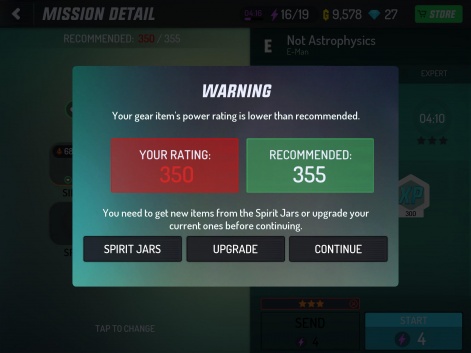
Aside from the aforementioned Spirit Jars, the answer to this is usually to upgrade your existing items.
This is done through Fusion Boosters, which are awarded as mission rewards and in free Spirit Jars every four hours, which can be used to increase an item's stats. If you use enough boosters, the item will be levelled up.
Gangstar New Orleans also includes bundles priced in real money.
When it reaches the level cap for its star level, it can be evolved using another resource called Jujus. These are occasionally given as rewards, but they can also be bought as part of certain bundles.
Monetising early
In addition to the more traditional hard currency-based purchases as detailed above, Gangstar New Orleans also includes a handful of bundles priced in real money.
And while the value of these surely increases based on player spending behaviour, the three bundles available at the outset are very low-priced at $1.49, $5.49 and $7.49.
The first two are starter bundles, while the latter - called The Daily Order - is a pack that can only be purchased once a day.
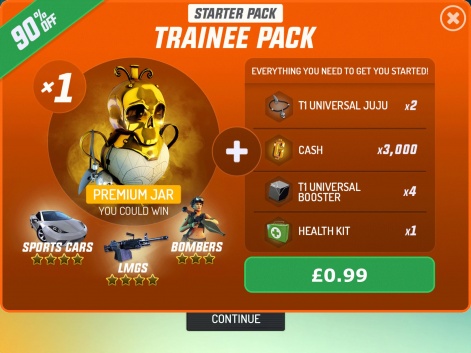
The Trainee Pack is the best deal at $1.49, 90% off its usual price, offering one premium (two to four star) Spirit Jar, two Tier-1 Universal Jujus, 3,000 Cash, four Tier-1 Universal Boosters and a Health Kit.
The Trainee Pack offers a hefty 90% saving.
Given that the combined cost of a premium Spirit Jar and a Health Pack (100 and 30 Diamonds respectively) under normal Diamond pricing is approximately $4.80, this is a hefty saving.
Old ideas, new execution
Gangstar New Orleans' monetisation design doesn't shake things up too much, then. There's no single mechanic or idea, a la Clash Royale's delayed chest rewards, that we've not seen before.
Instead, it takes different elements - the gacha mechanics from an RPG, the energy system of a shooter and the upgrade cycle of a racing game - and creates a functional system.

It works well for the most part, with unlimited free-roam in the open-world preventing the energy system from grating too heavily and some enticing discounts for new players.
But perhaps thanks to the array of monetisation design cues taken from elsewhere, maybe due to other game design decisions, Gangstar New Orleans doesn't feel like the game that's set to establish the open-world genre as a going concern for F2P mobile game developers.
It deserves credit, however, for being the first.
